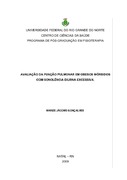Please use this identifier to cite or link to this item:
https://repositorio.ufrn.br/handle/123456789/16672| Title: | Avaliação da função pulmonar em obesos mórbidos com sonolência diurna excessiva |
| Authors: | Gonçalves, Marize Jácome |
| Advisor: | Bruno, Selma Sousa |
| Keywords: | Obesidade;função pulmonar;Sonolência diurna excessiva;Marcadores antropométricos;Ronco;Obesity;Pulmonary function;Daytime sleepiness;Anthropometric markers;Snoring |
| Issue Date: | 30-Jul-2009 |
| Publisher: | Universidade Federal do Rio Grande do Norte |
| Citation: | GONÇALVES, Marize Jácome. Avaliação da função pulmonar em obesos mórbidos com sonolência diurna excessiva. 2009. 99 f. Dissertação (Mestrado em Movimento e Saúde) - Universidade Federal do Rio Grande do Norte, Natal, 2009. |
| Portuguese Abstract: | Introdução: A obesidade acarreta prejuízo na função pulmonar relacionada à magnitude da adiposidade e se associa a sonolência diurna excessiva (SDE) e ronco como sintomas de distúrbios respiratórios relacionados ao sono. É possível que indivíduos obesos com sonolência diurna excessiva possam apresentar alteração na função pulmonar monitorados na espirometria durante o dia como conseqüência da fragmentação do sono ou de episódios de hipoventilação noturnos que ocasionam modificações respiratórias e que podem persistir durante o dia. A associação destes achados isolados de sonolência, observados através de escalas subjetivas com a função pulmonar em obesos, é desconhecida. Objetivos: Avaliar a influencia da SDE e do ronco na função pulmonar em obesos mórbidos e distinguir entre os distintos marcadores antropométricos, o ronco e a SDE quais os melhores preditores da função espirométrica e da força e resistência muscular respiratória destes pacientes. Métodos: Foram avaliados 40 obesos mórbidos quanto aos marcadores antropométricos, as variáveis respiratórias espirométricas, pressões inspiratória e expiratória máximas (PIMáx e PEMáx) e ventilação voluntária máxima (VVM) e mensuradas a sonolência diurna excessiva (Escala de Sonolência de Epworth) e ronco (Escala de Ronco de Stanford). Os dados foram tratados quando as diferenças entre os grupos de obesos com e sem sonolência, considerando as variáveis antropométricas, respiratórias e o ronco. A correlação de Pearson foi realizada e a análise de Regressão Múltipla avaliou os preditores da função pulmonar. Para tal foi utilizado o software SPSS 15.0 para windows e p<0,05. Resultados: 39 obesos foram incluídos (28 mulheres), idade 36,92+11,97a, índice de massa corporal (IMC) 49,3+5,1kg/m², relação cintura-quadril (RCQ) 0,96+0,07 e Circunferência do Pescoço (CP) 44,1+4,2cm. Os valores espirométricos e de pressões respiratórias encontravam-se acima de 80% dos valores preditos, exceto a resistência (VVM<80%). Obesos com SDE apresentam menor volume corrente. Foi observada correlação positiva entre SDE e IMC, SDE e CP e entre ronco e IMC; e correlação negativa entre SDE e Volume Corrente, ronco e CVF e entre ronco e VEF1. Na regressão linear o melhor preditor da função pulmonar foi o ronco, seguido da CP. Obesos com maior CP tem maior força (PEM; p=0,031) e resistência (VVM; p=0,018) muscular respiratória. Conclusão: Obesos com SDE tendem a ter menor VC. Além disso, o ronco e a CP podem melhor predizer a função pulmonar em obesos quando comparados aos demais marcadores antropométricos e a SDE. Obesos com maior CP tendem a ter maior capacidade de geral força dos músculos respiratórios, entretanto podem apresentar baixa resistência muscular |
| Abstract: | Background: Obesity impairment to the pulmonary function related to the magnitude of adiposity and is associated with excessive daytime sleepiness (EDS) and snoring, among others symptoms of respiratory disorders related to sleep. It is possible that obese individuals with excessive daytime sleepiness may make changes in lung function on spirometry monitored during the day as a consequence of fragmented sleep or episodes of nocturnal hypoventilation that cause respiratory and changes that can persist throughout the day. The combination of these findings alone sleepiness observed by subjective scales with pulmonary function in obese patients is unknown. Objective: To assess the influence of EDS and snoring on pulmonary function in morbidly obese and distinguish between different anthropometric markers, the snoring and sleepiness which the best predictors of spirometric function and respiratory muscle strength and endurance of these patients. Methods: We evaluated 40 morbidly obese markers on the anthropometric, spirometric respiratory variables, maximal inspiratory and expiratory pressures (MIP and MEP) and maximal voluntary ventilation (MVV) and the measured excessive daytime sleepiness (the Epworth sleepiness scale) and snoring (snoring scale of Stanford). The data were treated when the differences between the groups of obese patients with and without sleepiness, whereas the anthropometric variables, respiratory and snoring. Pearson's correlation was performed, and multiple regression analysis assessed the predictors of pulmonary function. For this we used the software SPSS 15.0 for windows and p <0.05. Results: 39 obese patients were included (28 women), age 36.92+11.97y, body mass index (BMI) 49.3+5.1kg/m², waist-hip ratio (WHR) 0.96+0.07 and neck circumference (NC) 44.1+4.2 cm. Spirometric values and respiratory pressures were up 80% of predicted values, except for endurance (MVV <80%). Obese with EDS have lower tidal volume. Positive correlation was observed between BMI and EDS, EDS and NC and between snoring and BMI, and negative correlation between EDS and tidal volume (TV), and between snoring and snoring FVC and FEV1. In linear regression the best predictor of pulmonary function was snoring, followed by NC. NC has more obese with higher strength (MEP, p = 0.031) and endurance (MVV p = 0.018) respiratory muscle. Conclusion: Obese with EDS tend to have lower TV. In addition, snoring and NC can better predict pulmonary function in obese when compared with other anthropometric markers or EDS. Obese patients with higher NC tend to have greater capacity for overall strength of respiratory muscles, but may have low muscle endurance |
| URI: | https://repositorio.ufrn.br/jspui/handle/123456789/16672 |
| Appears in Collections: | PPGFS - Mestrado em Fisioterapia |
Files in This Item:
| File | Description | Size | Format | |
|---|---|---|---|---|
| MarizeJG.pdf | 1,47 MB | Adobe PDF |  View/Open |
Items in DSpace are protected by copyright, with all rights reserved, unless otherwise indicated.

